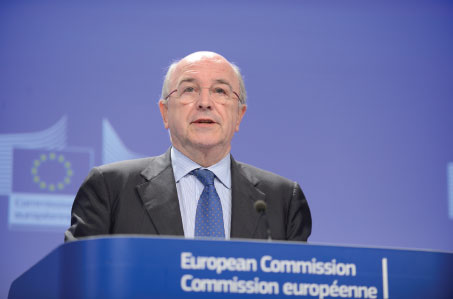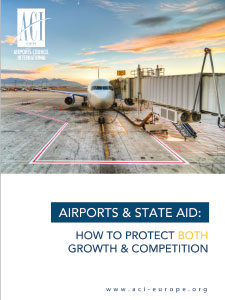
Joaquín Almunia, Commission Vice-President in charge of competition policy, maintained that the new guidelines are a key ingredient for a successful and competitive European aviation industry. “They will ensure fair competition regardless of the business model – from flag carriers to low-cost airlines and from regional airports to major hubs.”
The announcement of the new guidelines on State aid to airports and airlines had been hotly anticipated since the public consultation on the new proposals concluded last September.
As previously reported in Airport Business, the issue of State aid, particularly in the aviation sector, is both complex and contentious. The new guidelines replace those introduced in 2005, which were widely deemed to be inadequately enforced. Significant market change has also occurred in the past decade, not least the exponential growth of low cost carriers, which has allowed regional airports to develop dynamically.
However, some of these smaller airports are exposed to harsh economic realities in a highly competitive environment. The figures are compelling – 73% of airports handling fewer than one million passengers, and 59% of those handling less than five million, are loss-making. Such airports have high per unit costs, structural disadvantage in generating non-aeronautical revenues and non-existent pricing power vis-à-vis the airlines. But as these airports constitute vital public transport infrastructure – essential for fostering economic and social development, connectivity and accessibility – clearer rules to facilitate such airports have been long overdue to enable airports to receive state support, where genuinely needed.

ACI EUROPE has been active in driving the debate and released its own analysis paper – Airports & State Aid: how to protect both Growth & Competition – last August in response to the public consultation.
ACI EUROPE has been active in driving the debate, engaging constructively with political leaders and European Commission (EC) officials throughout the review process, including Joaquín Almunia, Commission Vice-President in charge of competition
policy, who was responsible for steering the new guidelines. ACI EUROPE’s own analysis paper – Airports & State Aid: how to protect both Growth & Competition – was released last August in response to the public consultation, while ACI EUROPE has also reached out to wider stakeholders, partnering with the Assembly of European Regions (AER) – the largest independent network of regions in wider Europe. Meanwhile, last September ACI EUROPE held a joint hearing on the issue in the European Parliament, in cooperation with Union des Aéroports Français.
“European airports compete tooth and nail to retain and attract air services and these much-awaited new guidelines provide a more level playing field upon which to do so,” explained Olivier Jankovec, Director General, ACI EUROPE. “As well as serving the industry, these guidelines should be implemented in a way that better secures the many economic and social benefits associated with air access in the EU. Hopefully, they will also bring an end to the squabbling between different types of airlines, as the real world parameters of these new rules become clearer in the months ahead.”
Commenting on the new guidelines, Commissioner Almunia maintained that they are a key ingredient for a successful and competitive European aviation industry. “They will ensure fair competition regardless of the business model – from flag carriers to low cost airlines and from regional airports to major hubs,” he said. “Our aim is to ensure the mobility of citizens, while preserving a level playing field between airports and airlines.”
So, what do the new rules mean for airports?
The guidelines focus on three key areas: Investment in airport infrastructure, operating aid to regional airports, and start-up aid to airlines.
The new framework on funding for airport development and modernisation is based on decreasing aid intensity as air traffic grows. ACI EUROPE has expressed its support for this approach. But while the EC has recognised the unique social value of airports, a key issue is also the looming airport capacity crunch: EUROCONTROL’s figures are unequivocal and cannot be ignored – 12% of demand will be unaccommodated by 2035 because of insufficient airport capacity, meaning 240 million would-be passengers will be unable to fly. This will cost Europe’s airports and airlines an annual €40 billion in lost revenues. Fortunately, improvements to the initial EC proposals mean that airports handling 3-5 million passengers will now have greater investment opportunities than originally allowed.
Importantly, the possibility also exists for some public support for large greenfield projects, which is crucial if Europe is to maintain its global competitiveness – especially as the competing Middle East economies continue to make huge investments in both their airlines and airport hubs.
“One must not forget the fundamental purpose of Europe, which is to facilitate the free movement of citizens,” commented Thomas Juin, Director of La Rochelle Airport and President of Alfa-ACI (French speaking airports). “Therefore the main issue for the coming years lies in the lack of airport capacity, which we must address in order to avoid Europe being disadvantaged compared to other parts of the world.”
Operating aid to regional airports
The most contentious element of the EC’s initial proposals was that, following a 10-year transitional period, airports with an annual throughput exceeding 200,000 passengers would no longer be able to receive public operating aid. This has been reconsidered and the guidelines now include a special regime for airports handling up to 700,000 passengers, although the EC has stopped short of providing long-term certainty for regional airports and their communities by indicating that this regime will be reassessed after five years.
Jankovec asserted that the structural and financial challenges that regional airports face today will remain in 2019 and are indeed likely to intensify. “We already know that regulatory-induced costs are going to increase for airports, while newly permitted levels of operating aid will stand at just 80% of current operating funding gaps,” he said. “When the decision-time comes around again, we will simply not be in a position to get this wrong otherwise some airports, in the worst case scenario, could be at risk of closure.”
Start-up aid for new routes
Perhaps the area that has generated the most media attention has been start-up aid to incentivise airlines to introduce new routes to regional airports. This assistance will continue to be permitted, provided it remains limited in length of time, and ACI EUROPE has commended the thought and focus given to this aspect of the regulation of start-up aid. “However, the implementation and enforcement of these new rules will ultimately determine whether clarity and simplicity have been achieved,” explained Jankovec. “With this in mind, we eagerly await the precedents set by forthcoming decisions on individual cases.”
The formal adoption and publication of the new guidelines in the Official Journal of the European Union is expected by the end of March, and Europe’s airports will wait with interest to see how they are implemented.







